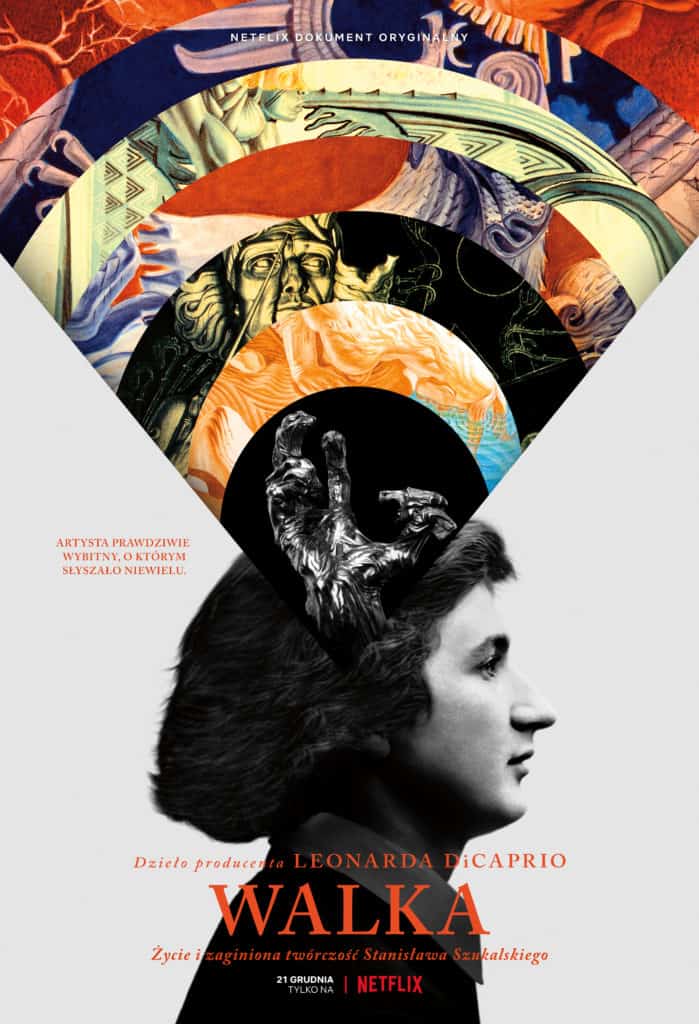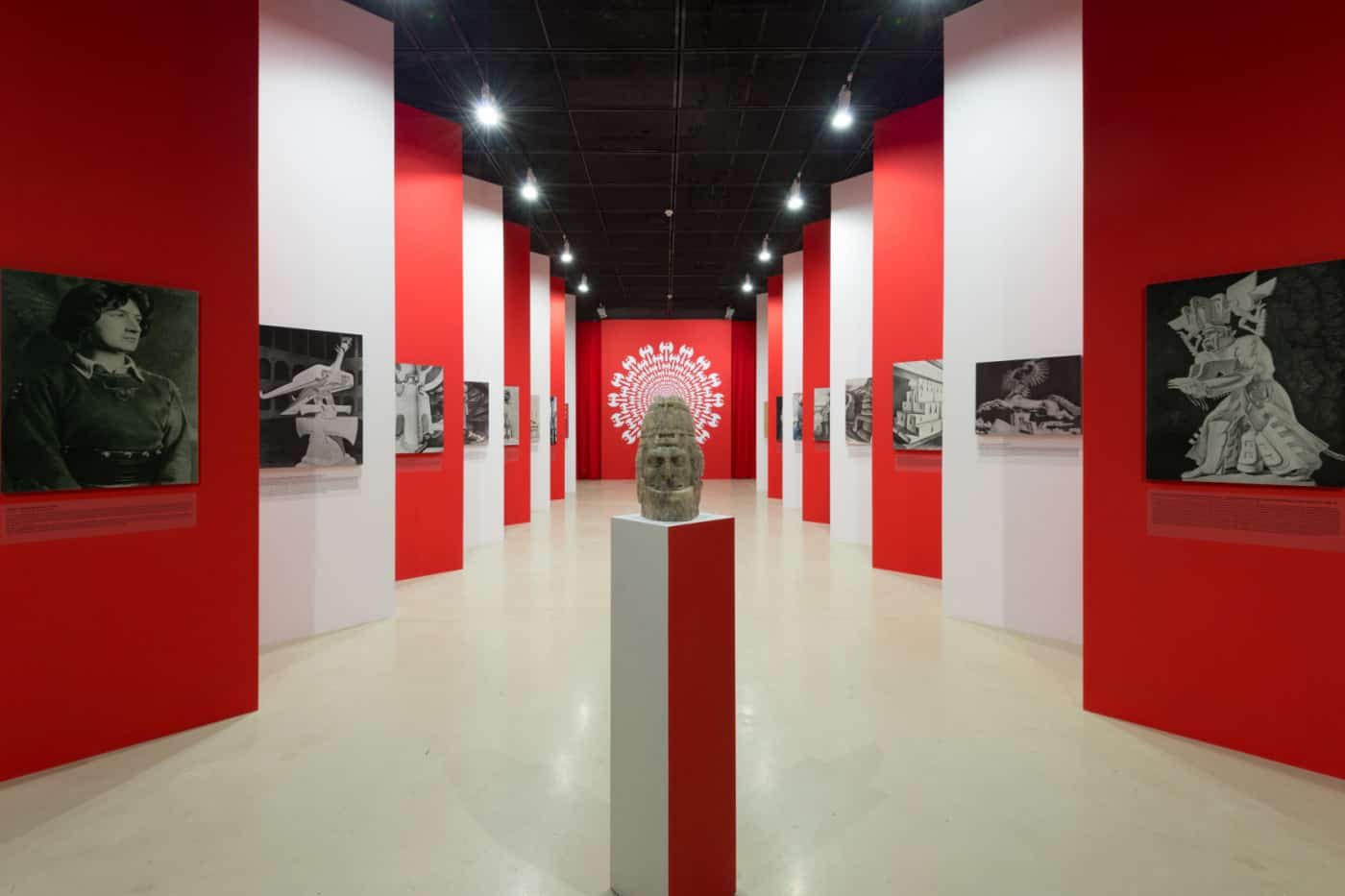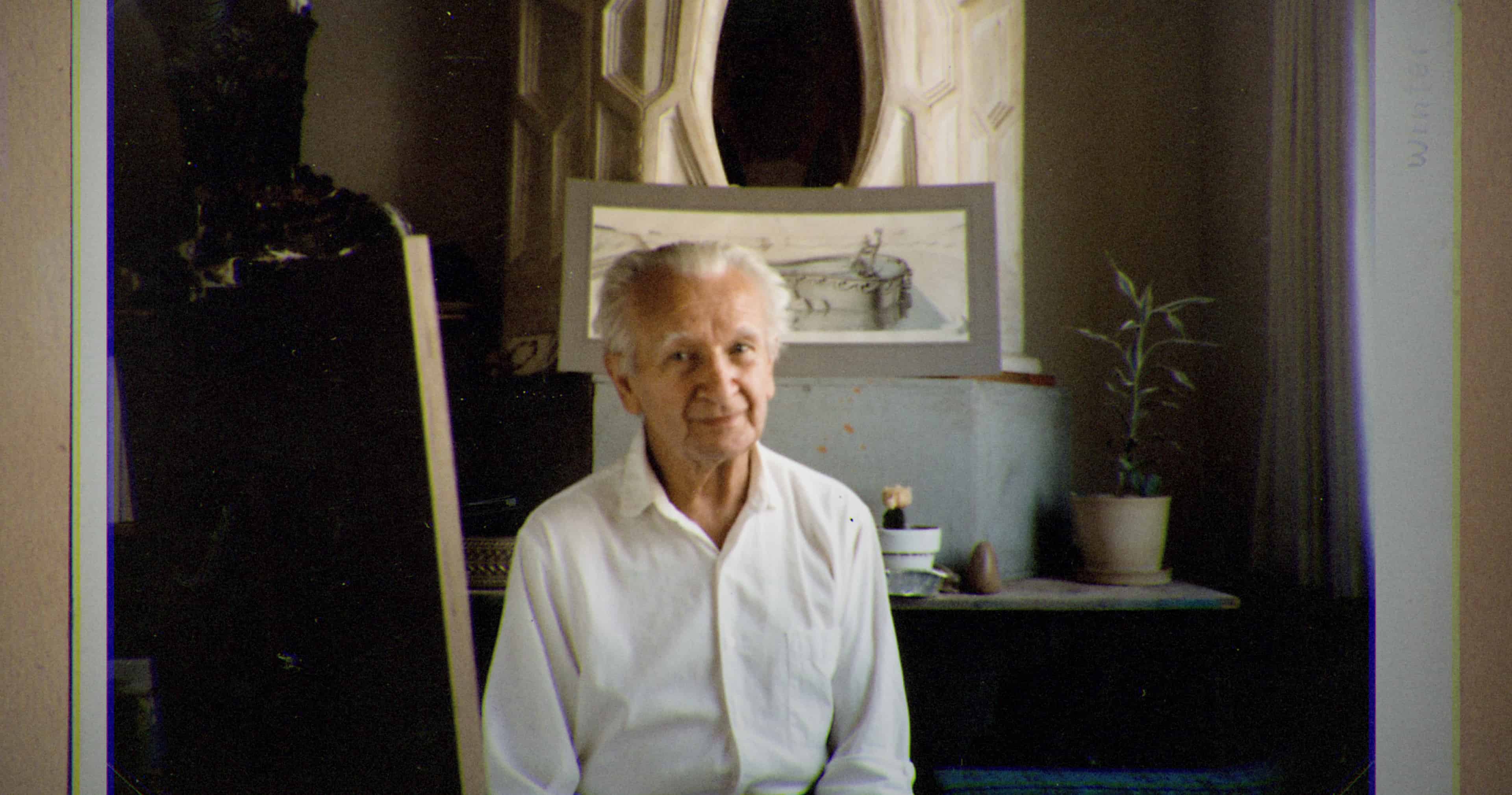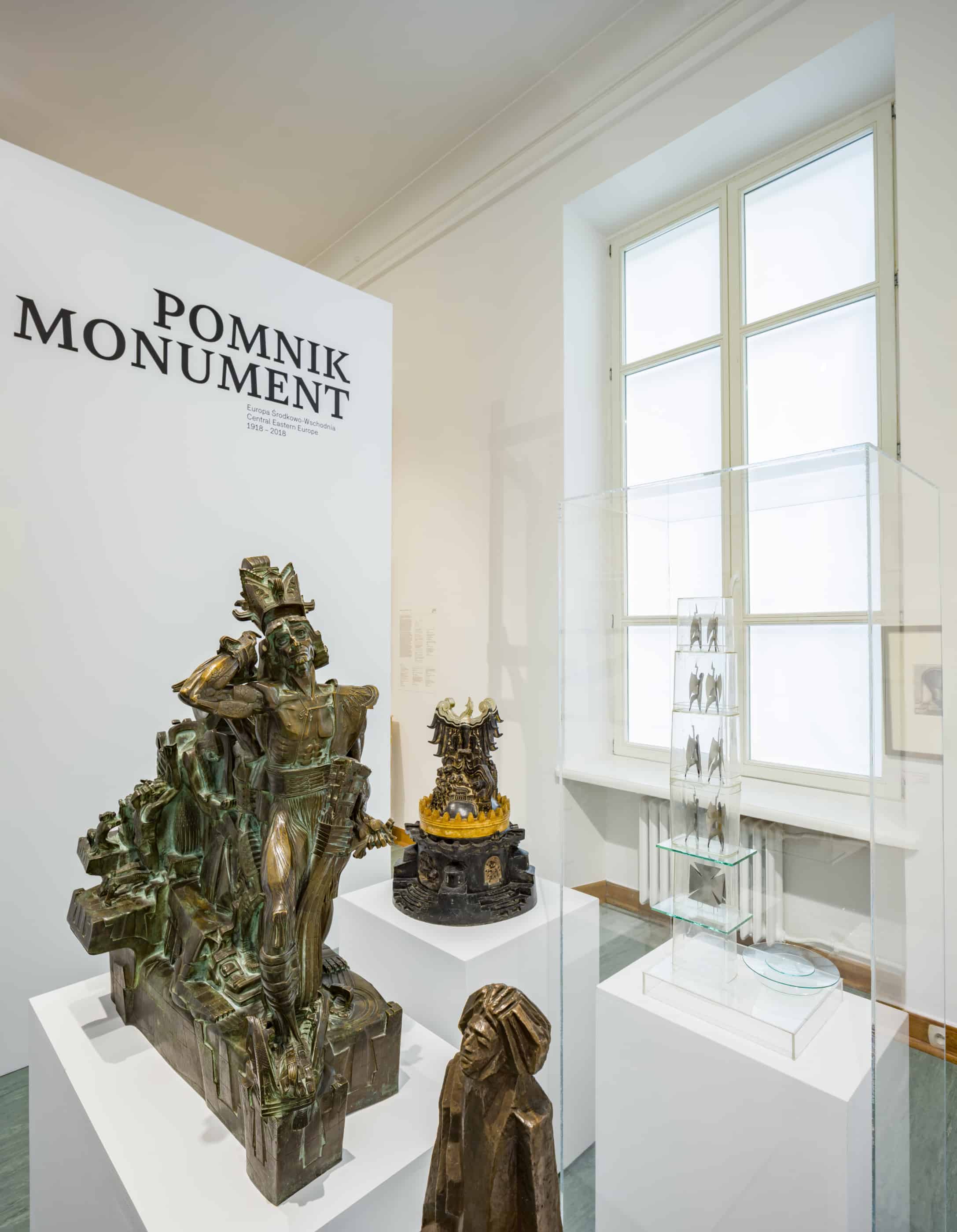
Stanisław Szukalski, portrait, courtesy Netflix Official Site
A new Netflix documentary about Stanisław Szukalski had been discussed in Poland quite some time ago. Talks began as soon as it was announced that Leonardo DiCaprio was going to finance a movie about this extraordinary Polish artist. The news was even more exciting and intriguing since not many people had known that such a gifted sculptor, who was almost like a family member to DiCaprio, ever lived in the United States. Stanisław Szukalski is not among the familiar names even for Polish art experts and devotees. Rarely is he an idol for those who do know him, but he is rather considered a controversial figure with ideas not easily accepted by the artistic community of today. Dedicated fans of the rock band Tool may have heard something about Szukalski because the band members are inspired by the artist’s works to a great extent. However, the group most familiar with his life and works are the promoters of the Old Slavic tradition, especially neo-pagan nationalists. They certainly could say a lot about Stanisław or Stach from the Warta River (Stach z Warty), as the artist used to call himself quite often. If those are the people interested in the life and adventures of the main hero in Struggle: The Life and Lost Art of Szukalski, then we can surely expect that his story is fascinating but involves many ideological struggles and serious controversies at the same time.

Poster of the movie “Struggle: The Life and Lost Art of Szukalski”, courtesy: Netflix Official Site
Stanisław Szukalski was born in Warta near Łódź in 1893. From an early age he eagerly used his vivid imagination and showed every sign of being talented in fine arts. He went to the US for the first time in 1907 to live with his father who worked there. This is when his frequent travels between Poland and America began, which lasted until the 1940s. He felt fine in both places and his talent was seen and respected by both communities. Despite that, he was struggling to find out where he really belonged. He was quite obsessed with Polish history and culture but, at the same time, he very quickly grew into the American lifestyle of flamboyancy on the verge of arrogance, and overbearing individualism that almost equalled self-creation. This was the trap he got himself into because he was never fully understood in America and his attitude prevented him from being approved and acclaimed in Poland (or Europe), where one needed to respect authority. His aggressive approach and exotic, individual artistic ideas were the reasons he did not manage to graduate from the Academy of Fine Arts in Kraków and made him an outsider unapproved by the Polish fine arts community. His political views were radical as well. Szukalski had an idea of a new form of Polish national art which would be based on Slavic heritage. This idea gained recognition by some elite political groups and was a big part of the Polish community of the 1930s. After World War II, Szukalski settled in Los Angeles for good. He even made several works which were used in Hollywood movies. However, he did not accept being a simple worker and he was deeply affected by the fact that the majority of his works were destroyed in Poland during the war. This was the moment his stardom started to fade away gradually. Even then, he did not abandon his unique ideas on art and eccentric anthropological concepts.

Exhibition view “Late Polishness. Forms of national identity after 1989” at Ujazdowski Castle Centre for Contemporary Art, photo: Bartosz Górka
Struggle: The Life and Lost Art of Szukalski mainly focuses on events in the 1970s and 1980s, i.e. the late stage of Szukalski’s life, when he was rediscovered by a group of underground, counterculture veterans. Among them was a publisher and occasional performer George DiCaprio (the father of Leonardo DiCaprio), a collector and enthusiast of comic books Glenn Bray, as well as their family members and friends. They were surprised that such fascinating artist lived in Los Angeles, so they started to visit him on a regular basis. What originated as a fascination with a somehow quirky old man quickly evolved into genuine friendship and later on transformed into a strong relationship which could equal family bonds. The young companions not only took care of Szukalski himself, but also embarked on a mission of getting various institutions interested in his works and achievements. Glenn Bray collaborated with his own wife and together they organised a few exhibitions of Szukalski’s works. It was also thanks to their efforts that several books about Szukalski were published. Improvised lectures which Szukalski delivered to his friends were also documented and recorded. Like a professional actor, he presented the story of his life, his art, an overview of his eccentric views and opinions and his own conception about the origin of humans, called zermatism. Bray has long hours of such recordings at his disposal and they are the main input material for the Netflix documentary.

Exhibition view “Late Polishness. Forms of national identity after 1989” at Ujazdowski Castle Centre for Contemporary Art, photo: Bartosz Górka
The director of the film is documentary filmmaker Irek Dobrowolski, who depicted Szukalski as a paradoxical and multi-dimensional figure. The Polish patriot, who was devoted to Polish and Slavic ideas and heritage and was deeply critical about American culture, became a surprising hero for a bunch of mediocre post-hippies. In a way they saved his life. This unusual situation became the starting point for the director, which allowed him to explore internal conflicts and mental struggles that bothered not only Szukalski, but also his admirers. The beginning of the film shows only the American perspective. Szukalski seems a fascinating but strange man whose life was not all roses. We find out that in the past he was a leader of Chicago’s bohemia, and had an unquestionable talent and great imagination. Then Dobrowolski gradually uncovers past events to us. Experts helped him present a different, Polish narrative on the artist’s activities. This is not only a story about an arrogant eccentric, but also a disturbing picture of an avid nationalist and pagan ideologist with para-fascist inclinations, who was even a member of anti-Semitic organisations. Szukalski’s American friends were not familiar with this part of the artist’s biography which, when uncovered, left them deeply shocked. Each of them reacted to what they learned differently – some were critical and detached while others eagerly defended the artist because they believed that as he got older he became a different, better man. Irek Dobrowolski does not officially support any of these attitudes. Nevertheless, in the movie we can see that the “milder” American view of Szukalski’s transformation dominates in the end. Struggle is a fascinating study of duality and ambivalence. It is also a story about a guru and his followers who learn the truth about their prophet after many long years. This experience is never enjoyable and easy – this we can say for sure.

Exhibition view “Late Polishness. Forms of national identity after 1989” at Ujazdowski Castle Centre for Contemporary Art, photo: Bartosz Górka
At the beginning, I mentioned that the Polish artistic community was in opposition to Szukalski. The reason for this dislike and reluctance was the artist’s devotion to certain ideologies, but also controversial aesthetic qualities of his works which were over-expressive and monumental. The establishment did approve of the fantastic elements in Szukalski’s works. Such elements were not in line with modernist trends and, therefore, were considered kitsch. Nevertheless, the artist intrigues many and in recent years he has been mentioned increasingly frequently, however usually with negative connotations. The exhibition Late Polishness (2017) organised at U-Jazdowski Centre for Contemporary Art in Warsaw was an important event which attempted to remind the audience of Szukalski’s works. The event emphasised that these works are a troublesome heritage to us and provided inspiration for a discussion about the role of the nation in contemporary Polish art. Maurycy Gomulicki was responsible for the part of the exhibition which included Szukalski’s works. He is open about the fact that he is deeply fascinated with Szukalski, which started with strong admiration at a young age. As he got older he gained more perspective, but he continues to be interested in this unique figure. This is yet more proof that the artist’s charisma, emphasised in the film Struggle, affects people today.

Stanisław Szukalski, a still from the movie “Struggle: The Life and Lost Art of Szukalski”, courtesy: Netflix Official Site
Perhaps it was not a coincidence that Szukalski’s admirers were enthusiasts of comic and fantasy books. His works remind us of other artists who created their own, fantasy-based mythology and were subsequently rejected by the art establishment. They found their space in popular culture and attracted their own groups of “worshippers”. Painters such as H.R. Giger and Zdzisław Beksiński are a rich source of inspiration for pop culture artists. But Szukalski has the most in common with another artist – the “rejected” writer H.P. Lovecraft, who is the founding father of modern American horror books. Both artists imagined very similar things and their views on life were quite homogenous. They both lure their audiences with similarly incredible marvels. They also both have very radical attitudes, close to racism (anti-Semitism for Szukalski and white suprematism for Lovecraft), which is disconcerting for fans. The problem I just mentioned was presented quite mildly by Irek Dobrowolski in his film.
Szukalski’s change of attitude, which we see in Struggle, most likely never happened. Szukalski’s zermatism was about finding the roots of a strong and noble race, which certainly does not depart from radical, racist inclinations. His interest in ethnography was similar to what Leni Riefenstahl tried to present after the war. We also know that Szukalski was in mail contact with Polish pro-Slavic circles for a long time. In the movie, these incriminating facts were hidden behind personal, often moving stories told by Glenn Bray who defended his Polish friend with teary eyes. He took care of him until his death, but, as it turned out, he did not know everything about his past. I think that these personal touches are the most valuable parts of Struggle: The Life and Lost Art of Szukalski. In general, this is another instance where art, life, official ideologies and intimate scenes from everyday life do not form a coherent picture.
Struggle: The Life and Lost Art of Szukalski, 2018, directed by Irek Dobrowolski, is available on Netflix now
Written by Karol Szafraniec
Translated by Joanna Pietrak
Proof read by Maggie Kuzan

‘MONUMENT. Central and Eastern Europe 1918–2018’ exhibition, The Xawery Dunikowski Museum of Sculpture, © Ernest Wińczyk / MNW Królikarnia








